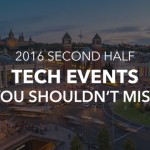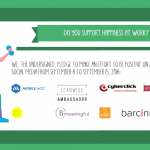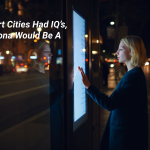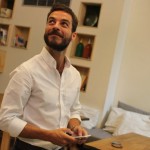This post is not about the well-known book of Tom Kelley on the design innovation focus of IDEO and his lessons on creativity: Art of Innovation. It is about art and innovation. Or even better, how they go hand-in-hand in our very own city of Barcelona. You just have to go to the MACBA, visit the exposition ‘art, two points’ on the ground floor and have a look at the artwork titled ‘Flags for Organizations’ from Art & language in 1978.
Four flags in four different colors are attached to the wall. Red, Blue, Yellow and Green. Each flanked by a bullet point manifest, resembling a different perspective on society. The composition somehow makes you reflect on the French Revolution with Marianne raising the flag for “Liberté, égalité and fraternité”. Each color representing one of these values. But, there are four flags in this art piece instead of three. How come? The power of innovation, of progression and change is added as a fourth value to the canon. When you read the manifest of the yellow flag, you start to acknowledge the spirit and conditions for entrepreneurship. Very true and inspiring to see it reflected in such a way.
That there is a strong relation between art and innovation is a topic covered often. To quote an article on John Maeda in the Guardian: “Innovation in the sciences is always linked in some way, either directly or indirectly, to a human experience. And human experiences happen through engaging with the arts – listening to music, say, or seeing a piece of art.” He continues with “Art helps you see things in a less constrained space. Our economy is built upon convergent thinkers, people that execute things, get them done. But artists and designers are divergent thinkers: they expand the horizon of possibilities. Superior innovation comes from bringing divergents (the artists and designers) and convergents (science and engineering) together.”
It is nice to see that the museums are innovating themselves as well, to play a more central role in community, to facilitate different encounters and to get people out of their comfort zone to spark inspiration and innovation. Being raised with the prejudice that in a museum you have to talk quietly and watch with your eyes, I was pleasantly surprised by the ‘rebel’ corner at the MACBA. It invites you to touch the art. You are actually allowed to investigate an art piece with your fingers in order to achieve a better interpretation and experimentation with the life of art. Of course, it is not the real Tapies you can stroke, but it does stimulate you to use more senses simultaneously. I see the different layers of paint and fabrics, but I feel smooth wood, itching sand and rocky stone. It brings you a step closer to the desired extra dimension: a visible trend with our fascination for 3D or even 4D technology. And isn’t innovation partly a rebellious act against established products, facts and opinions: the status quo?
A recent OECD report on Art for Art’s Sake? The Impact of Arts Education, shows how art fosters skills such as critical and creative thinking, motivation, self-confidence, and the ability to communicate and cooperate effectively. It notes that the way to foster skills for innovation may well be through the arts and it is this ambition that is adopted by the centre of educational research and innovation (CERI).
Also big companies are investigating the relation between Art and Innovation. Deloitte started a debate on the continuum art versus innovation, nicely reflected in the following table.
To stimulate the inspiration, the MACBA has a relaxing launch with fatboy cushions to rest on and free wifi. Then, simply by looking up, you can see the inspiring words applicable for the wonders of both art and innovation:
Some objects of desire
+
some objects of necessity
+
some objects of no concern
–
those things that escape notice
÷
a force majeure
=
some things
With the autumn beginning and the rainy days in the weekend, it is definitely worth a trip to the MACBA to get inspired and read the bullets of the manifest. I wonder whether you agree if the yellow flag stands for disruptive innovation. Don’t want to wait for the weekend to get inspired? Have a look at the work of Daan Roosegaarde, winner of the INDEX design award 2013: a true master in combining innovation and technology for the sake of art (and functionality).
Image credits: Deloitte, Mr. Gammon Draws, MACBA, Dune










Leave a Reply